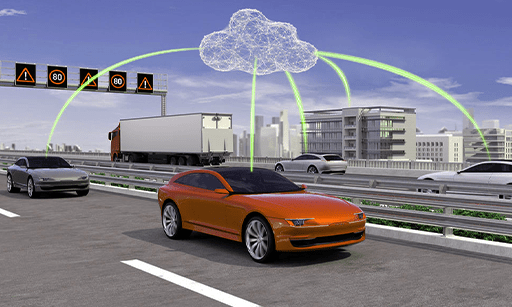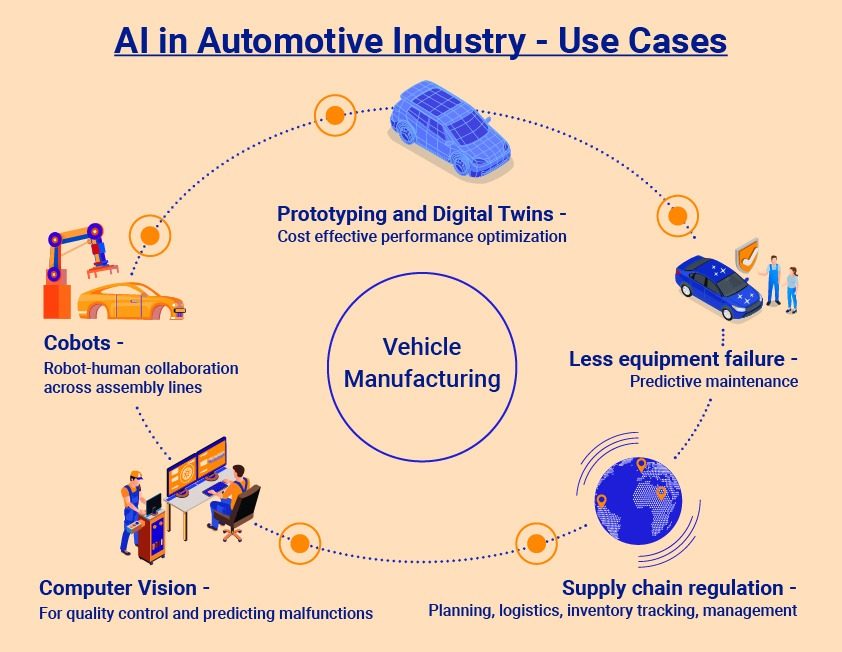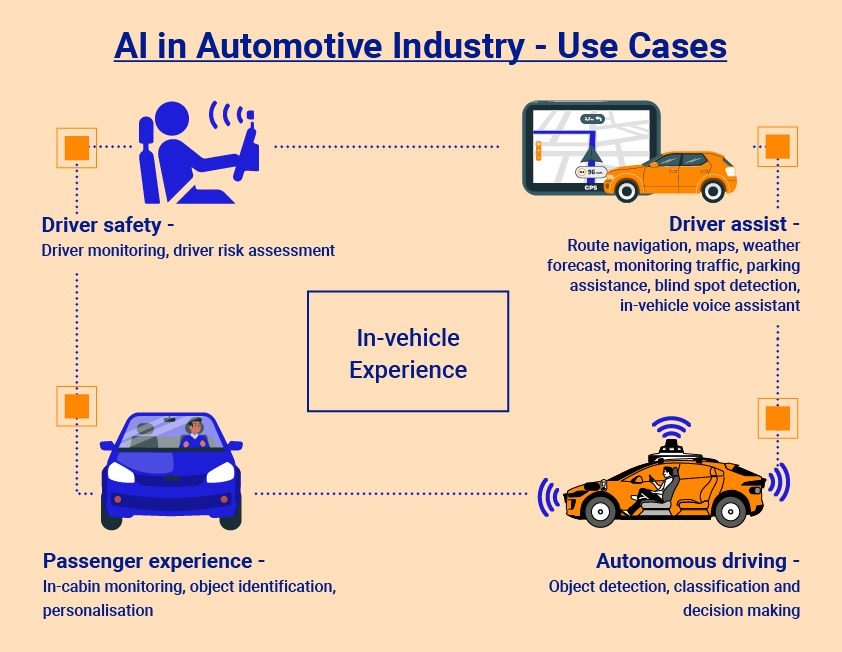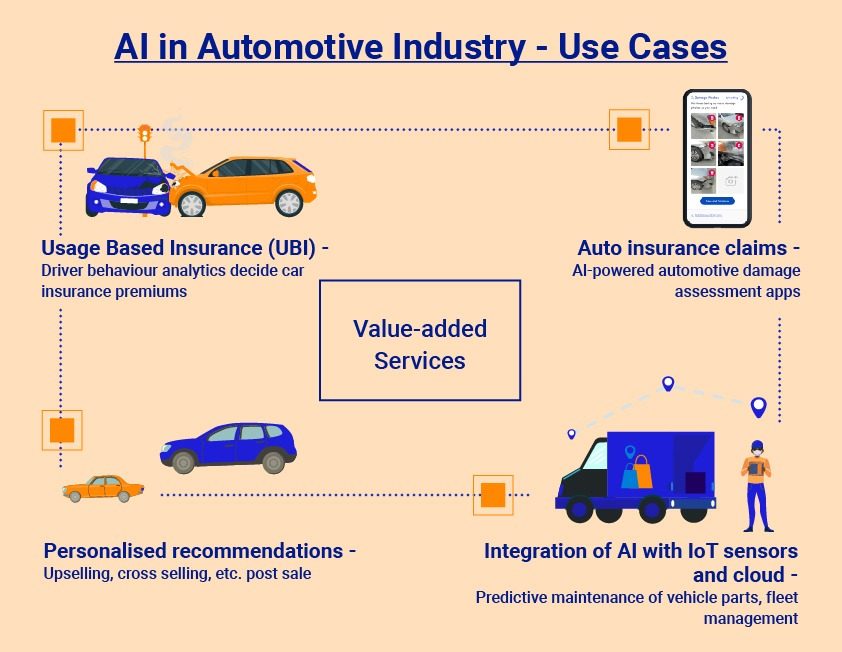The automotive industry is at the cusp of a phenomenal transformation.
Modern cars equipped with AI-powered Advanced Driver Assistance Systems (ADAS) are manoeuvring and finding parking spots themselves. Vehicles are even able to detect when the driver is tired and send alerts to keep them awake and safe!
About a decade or two ago, these features would only have been envisaged in science fiction movies or books. But things are different today.

Automakers have started incorporating advanced technologies in their products and operations to ensure that they stay a step ahead of competitors in the market.
Hence, the modern automobile is increasingly being fortified with IoT technologies like:
- • Sensors that gather valuable data about vehicle condition and driver behavior
- • Complex machine learning (ML) algorithms that convert the collected data to insightful reports, and
- • Applications that use this data to segment customers and provide individualized offers
These are some of the most prevalent use cases of artificial intelligence in the automotive industry today.
Automotive OEM-Technology Provider Nexus
The relationship between automotive OEMs and niche software technology solution providers have only strengthened due to tech advancements in AI.
As a trusted technology partner for global automotive OEMs and Tier 1 Suppliers, Embitel has been developing transformative solutions for connected cars of the future.
Our IoT team consisting of experts in artificial intelligence (AI), cloud technologies and embedded software have been combining business understanding with powerful tools and processes to deliver customised solutions for our clients.
In this article, we explore the application of artificial intelligence in the automotive industry. We also touch upon some AI/ML based solutions that we have conceived at our IoT Innovation Lab in Bengaluru.
AI Use Cases in the Automotive Industry
The visionaries in the connected car and autonomous driving arena take advantage of AI and data science for developing disruptive automotive technologies.
AI in Vehicle Manufacturing
Welcome to the world of collaborative robots working hand-in-hand with humans to boost the efficiency of manufacturing operations!
Analytics has proven to be an extremely powerful tool in the manufacturing value chain. To realize the full potential of data science, it is important to analyze and collect data from various functions across the manufacturing life cycle.
This means that an end-to-end analytics strategy that covers workforce analytics, asset/inventory management and operational planning is crucial for getting the complete picture for generating insights.
Use Cases:

Artificial intelligence in car manufacturing helps automakers reduce manufacturing costs and provides a safer and more efficient factory floor.
- Cobots (collaborative robots) – These are emerging as heroes here, as they are increasingly appearing on factory floors to put together the nuts and bolts of the vehicles!
- Computer Vision - AI-based systems powered by Computer Vision can easily identify product anomalies and reinforce quality control. AI also helps in predicting malfunctions in automotive parts.
- Prototyping and Digital Twins - ML algorithms can be utilized for prototyping products and simulation. These days, automakers are using Digital Twins which are more cost-effective than physical prototypes. Digital Twin technology helps engineers analyse how specific designs can impact the vehicle’s performance.
- Supply Chain Regulation - Why should data science be restricted to only the manufacturing modules? When its application is extended across the entire business, planning, logistics, inventory tracking and management are more streamlined.
- Less Equipment Failure – IoT sensors fitted to the manufacturing equipment can gather data from machine parts. This data is then utilised by an AI subsystem that identifies performance discrepancies and notifies the factory personnel about a possible equipment failure. They can then take the necessary steps to fix the issue before it even occurs! This is a classic example of predictive maintenance in Industry 4.0.
How AI Transforms In-vehicle Experiences
The alluring vision of vehicle autonomy and growth expectations for the global autonomous vehicle market has ascertained one thing – AI is an intrinsic part of automotive tech development.
And automotive OEMs are increasingly adopting AI to transform in-vehicle experiences.
Use Cases

Driver Safety
Driver distraction, drowsiness and rash driving are some of the leading causes of road accidents globally.
AI and Deep Learning based automotive applications can offer a plethora of valuable in-car analytics. Cameras and IR sensors can detect the driver’s behavior accurately and provide warning signals to avoid accidents.
a) Driver distraction – Machine learning based apps can detect driver distraction and provide early warning signs.
For instance, a driver may be engaged in several other activities while driving. This includes attending calls on a mobile phone, texting, reaching out to the back seat, talking to passengers, smoking, or reaching for the infotainment system to play music. These activities are generally classified as driver distraction activities, and they usually take the driver’s attention off the roads.
DriveSafe, a real-time driver distraction detection app incubated at the Embitel Innovation Lab, can analyze driver actions and classify the activities as “focused” or “distracted”. The driver is then notified of distracted driving through audio and SMS alerts, so that they can bring their focus back on the road.
b) Driver drowsiness – Driver distraction is not the only behavioural aspect that can be detected by ML-based apps. These apps can also detect eye openness and head position of a driver. If the driver is found to be drowsy, the app sends a notification to alert them.
c) Rash driving – IoT sensors can collect data on driver speeding, sharp turns, sudden braking, etc. This information can be analyzed continuously to form an impression of the driver’s behavior on the road.
Project Genie, a driver behaviour app developed at Embitel, can evaluate the driver’s road performance and provide feedback at the completion of each journey. This helps the driver understand the issues with their driving and take corrective actions to stay safe.
Here’s a demo of Project Genie:
Driver Assist
AI-powered automotive applications can detect road conditions in real-time so that drivers can be updated of construction work, accidents, speed limits and road closures before they start the journey.
The AI/ML engineers at Embitel have conceived an IoT-based smartphone app to analyze road conditions and provide appropriate navigation assistance to drivers based on these conditions. This app determines the most optimum path for the journey based on potholes, humps, and road closures. The driver is also warned of the approaching hump/pothole, around 100 meters before he/she reaches it.
In cities where there is frequent traffic congestion and road construction work, this information is very valuable for commuters.
If a person is driving in a new city, they would have to completely depend on a web mapping service for best route suggestion. They would not know about the untarred roads that may be part of the optimized path suggested by the app.
The smartphone app developed by our engineers can combine road condition info and traffic details to provide the best path suggestion.
Here are some other applications of AI in driver assistance:
- • AI powered apps or ADAS systems can provide information on weather forecast, nearby parking slots and blind spots while driving.
- • In-vehicle voice assistants help drivers to stay connected while focusing on the road. Such voice recognition software can adjust the temperature inside the cabin, provide updates on fuel, switch radio channels, and make phone calls for the driver.
- • Most versions of these apps can also provide personalised experiences by remembering the driver’s preferences (such as seat heating, seat position, etc.) and making adjustments accordingly.
Passenger Experience
High-end modern vehicles are equipped with AI-based occupant monitoring systems. Such systems can identify the occupants in the car and even segregate them as humans or pets.
AI-based in-cabin monitoring systems make use of various types of sensors (passive, ultrasonic, pressure, weight, camera, gas, microphone, or radar) to detect seat occupancy and the presence of children. This system can also be integrated with other safety subsystems such as continuous monitoring or seat belt tightening systems.
Since this technology notifies the driver of children or pets in the vehicle, it can mitigate life-threatening incidents like heat strokes. If there is a collision, the system can adjust the seat positions to ensure that the children are optimally protected.
We have highlighted many more benefits of this technology in our blog on in-cabin monitoring systems.
Artificial Intelligence in Autonomous Vehicles
Autonomous vehicles view, perceive and make decisions in split seconds. AI, ML and computer vision technologies facilitate in assessing the outside world. In addition, edge and cloud computing applications work in tandem to convert massive volumes of vehicle data into real-time actionable insights.
Companies like Motional, Waymo, Zoox and Refraction AI are pushing the boundaries of AI innovations in vehicles and have been able to get the first set of self-driving cars on the roads.
- • Motional’s vehicles use data collected by LiDAR, radar and camera sensors to realise the dream of the world’s first robotaxi.
- • Waymo’s self-driving vehicles leverage 360-degree perception technology to accurately detect and classify objects on the road.
- • Zoox has transformed the ridesharing market with its army of autonomous vehicles.
- • The robotic self-driving vehicles manufactured by Refraction AI provide faster and cheaper delivery services for groceries, takeaway dinners and medicines. These vehicles are designed suitably for prioritizing delivery time when making their way through traffic.
Value-Added Services on a Platter, Served by AI
AI has a notable impact on aftermarket sales for automotive OEMs. Let’s take a look at this in detail.
Use Cases

- Usage Based Insurance
Heard of Pay As You Drive (PAYD) or Usage Based Insurance? This is a new form of auto insurance that determines your premium based on factors like how many miles you drive or how safe you are on the roads. This type of insurance uses telematics technology to monitor the driver and the vehicle.
The insurance industry can leverage driver behavior analytics to determine car insurance premiums for customers. Insightful risk profiles are created for each driver based on their performance on the road, issues in personal life, health complications, and a myriad of other such factors that could affect their driving. This information is the basis for determining the premium.
- AI-powered Car Damage Assessment
Auto insurance companies perform strict evaluation of vehicle conditions and data processing when a claim is raised. Fraudulent claims or inaccurate assessments can be detrimental to the company, resulting in losses.
One of the challenges faced by insurers is the delay caused by manual inspection of vehicles. Assessment of the exact vehicle damages and estimation of health damages are all manually performed. This can lead to inaccurate or delayed estimates.
The human intervention involved in vehicle inspection can be replaced by a more efficient automated evaluation system, powered by AI. The sensor and camera-generated data from such a system can help in recreating the accident and speed up the incident investigation process.
-
Personalised Recommendations
The role of AI in the automotive aftermarket is noteworthy. New tools and processes can collect data and transmit it to the OEM for improved aftermarket operations.
The IoT data collected from vehicles can be matched against warranty data to understand more about the customers and products. This leads the way towards advanced analytics and intelligence on how to grow sales through distributors and retailers.
OEMs can send out real-time recommendations for upselling and cross-selling products and even forecast the effectiveness of product bundles. The OEM’s marketing team can configure personalised advertisements/shopping suggestions that pop up on the infotainment screens to capture the attention of the driver.
All this can be propelled by AI!
- Predictive Maintenance
Predictive Maintenance is perhaps one of the finest examples of how data science can be harnessed for adding value to automotive businesses.
Predictive analytics can be leveraged for vehicle maintenance recommendations.
ML algorithms can give recommendations to drivers about vehicle maintenance. Based on the past occurrence of an event/issue, it is possible to predict when the next such issue may happen!
So, for instance, the data collected by a vehicle’s sensors may indicate gradual overheating, friction or noise. These issues may also lead to the breakdown of a specific vehicle part in the future.
- The machine learning algorithm records these events regularly and analyses the frequency of occurrence of these issues.
- It also accurately predicts when the breakdown of the vehicle or part is expected, based on the findings.
- The driver can, hence, take precautionary measures by getting the vehicle inspected and maintenance activities scheduled to avoid such a breakdown. This is a classic example of predictive maintenance in automobiles.
Predictive maintenance also enables automotive OEMs to boost brand loyalty. OEMs are increasingly integrating predictive maintenance technology in their vehicles to improve customers’ compliance with vehicle maintenance schedules. This enhances customer satisfaction and boosts brand reputation.
Fleet Management - A significant use case of predictive maintenance in the automotive industry is in fleet management. IoT sensors collect data from the vehicles and send it to an AI-based system on the cloud. Further analysis of this data or computing in the cloud can provide intelligence on new channels for optimisation.
Fleet management companies utilize predictive maintenance to avoid unprecedented repairs and protect the ROI on each vehicle.
Trends in Autonomous Vehicle Technology
Since autonomous vehicles (AVs) are a hot topic of discussion in the industry, let’s take a look at some of the trends in AV technology:
- • Deep Learning - Modern computer vision systems use deep learning to achieve robustness and superior performance. Large neural networks with multiple hidden layers are leveraged for feature generation, training and prediction. Deep learning is widely used for automating automobile manufacturing assembly tasks. Visual inspection activities such as part identification, part selection, defect detection, etc. can be automated to improve product and process quality.
- • Edge AI - Another trend that has gained grounds in autonomous driving tech is the use of Edge AI applications. It is essential for autonomous vehicle subsystems to have extremely low latency. These systems should also be able to function if there is a temporary loss of internet connection. Edge AI applications are perfect for such use cases. Hence, autonomous vehicles are connected to the cloud, but most of the data processing activities happen locally.
Applications of Machine Learning in Autonomous Vehicles
Machine learning and computer vision technologies can process a large amount of data from camera sensors. This information is then combined with data from other sensors such as Lidar, in a process referred to as Sensor Fusion. Subsequently, this data can be used to generate the following insights:
- • Real-time prediction of collision
- • Driver distraction
- • Real-time detection of road conditions and road signs
The AI/ML engineers at Embitel’s Innovation Lab have developed a simulation testing environment for autonomous vehicles.
Check out our blog to understand how we are performing AV simulation testing to detect 3D objects and predict collisions - https://www.edn.com/av-simulation-testing-for-3d-object-detection-collision-prediction/
Predictions for the Future
A recent research report by GM Insights covered the AI trends and outlook for the automotive industry. The report states that the demand for autonomous vehicles will fuel the adoption of AI in the automotive industry.
Also, AI-based Advanced Driver Assist Systems (ADAS) are being incorporated in the newer models of vehicles.
Further, auto OEMs are increasingly relying on AI to improve the efficiency and maximise production on the factory floor.
Hence, AI is reinforcing its presence across various realms in the automotive value chain.
How Auto OEMs Can Adopt AI in a Sustainable Way
Since AI offers a myriad of opportunities to transform mobility, here are some actions that auto OEMs can take to benefit from this technology:
- Identify projects that can be automated with AI and machine learning. If you decide to invest in AI, check the technical feasibility of this proposal and its overall business impact.
- Partner with a reputable company with expertise in developing AI/ML solutions for the automotive industry. You can work together with this company to integrate the necessary architecture, data and algorithms for the AI solution.
- After implementation, monitor the AI solution closely to assess the performance. Document the process improvements brought about by this investment. Once the AI solution is fully functional, the operational knowledge can be transferred to the auto OEM from the partner company.
Conclusion
The automotive market is seeing increased competition, cost pressure and volatility. Even small interventions can help auto OEMs make great strides in increasing their market share. Since data science is emerging as a game-changer in the automotive industry, the opportunities offered by it are plenty.
The perfect time to adopt artificial intelligence for automotive applications is now. If you have an idea for an exciting AI/ML based application, reach out to us. We can help you in transforming your vision to reality!




